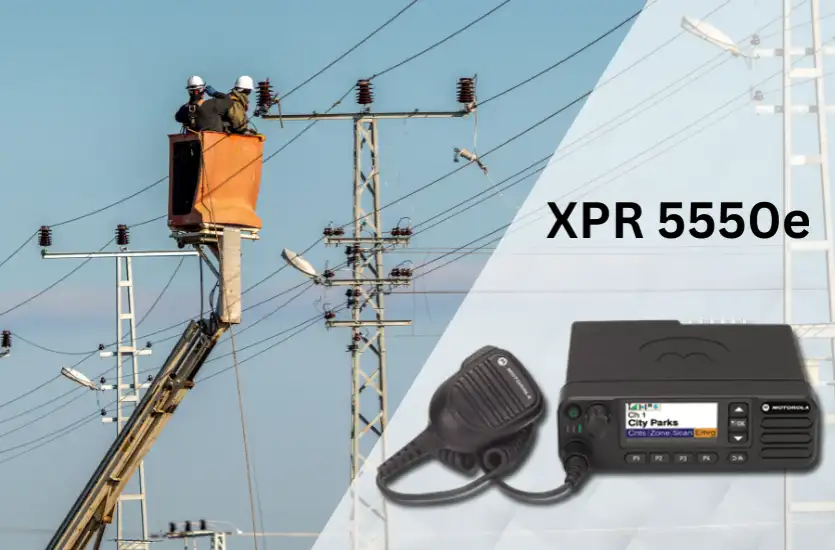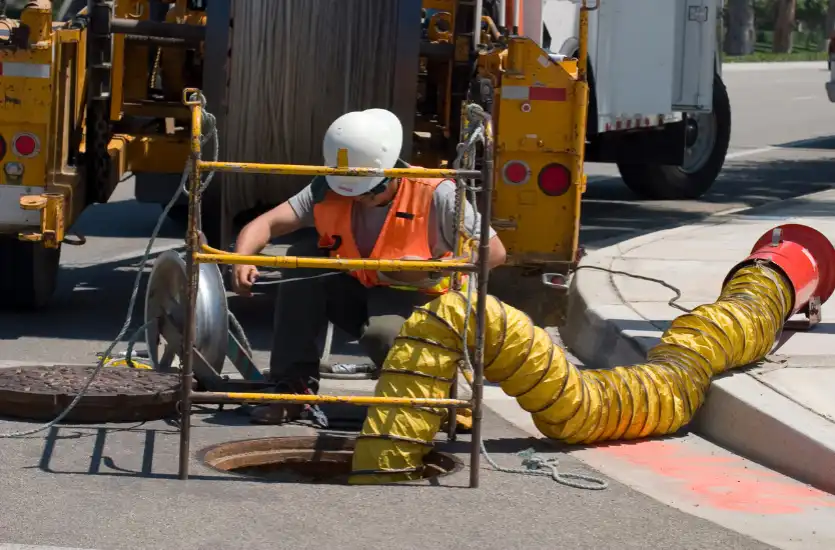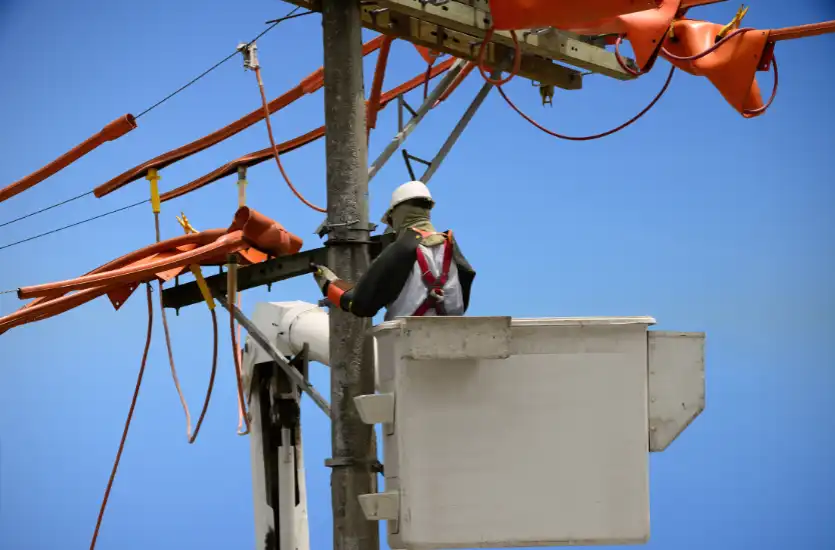Reliable communication isn’t just helpful in the utility industry—it’s the backbone of getting the job done right. Whether it’s coordinating a crew during a storm or checking in with teams spread out over vast areas, staying connected is key. But in remote and rural areas, where cell phone service is often spotty or nonexistent, this can be a real challenge.
Imagine trying to handle an emergency or complete a complex task without being able to reach your team—frustrating, right? That’s where two-way radios come in. Unlike cell phones, they’re built to work in those tough-to-reach spots, making sure everyone stays on the same page, no matter where the job takes them.
The Role of Two-Way Radio Solutions
Two-way radios are the go-to solution when you need reliable communication. Unlike cell phones that depend on towers and signals, two-way radios operate on their own frequency, making them dependable even in the most remote locations. They allow instant communication with the push of a button, so there’s no waiting or dropped calls—just clear, direct contact with your team.
For those working in especially challenging environments, like deep valleys such as the Steepheads or dense forests such as Florida’s Ocala National Forest, high-powered mobile radios can literally change the game. Mounted in vehicles and equipped with external antennas, these radios can reach places that regular devices simply can’t. They boost the signal range and help maintain strong connections, making sure no one is left out of the loop, regardless of where they are working.
Reliable Communication in Remote Areas is Not an Optional Program
When you’re out in the field, especially in remote or rugged areas, reliable communication isn’t just a nice-to-have—it’s a necessity. Think for a moment of a utility crew working in the middle of nowhere, tasked with restoring power after a major storm. The nearest cell tower is miles away, and the weak signal is barely enough to send a text, let alone coordinate a complex operation. In these scenarios, the limitations of cell phone service become glaringly obvious. Spotty coverage, dropped calls, and delayed messages aren’t just inconvenient; they can lead to serious delays, mistakes, or even accidents.
In remote utility work zones, the stakes are high. When communication fails, efficiency plummets, and safety is compromised. Crews can be left in the dark—literally and figuratively—without a reliable way to stay connected.
This is where two-way radios become the sought-after solution. Unlike cell phones, two-way radio solutions provide a direct line of communication that doesn’t rely on nearby towers or strong signals. They offer better range and reliability, allowing crews to stay in touch even when they’re miles from the nearest sign of civilization.
The ability to maintain constant contact not only boosts efficiency but also keeps workers safe. When every second counts, two-way radios confirm that no one is out of reach, no matter how remote the location.
High-Powered Mobile Radios
So, this all begs the question—what are high-powered mobile radios and how are they different from normal mobile radios? Here’s what you need to know.
High-Powered Mobile Radios for Challenging Environments
High-powered mobile radios are designed specifically for challenging environments where regular communication tools fall short. Unlike standard mobile radios, these devices offer significantly increased transmission power, which means they can send and receive signals over much greater distances. This increased power keeps the signal strong and clear even in remote or obstructed areas.
Additionally, high-powered mobile radios are built to stand the test of time. They feature rugged designs that can withstand harsh conditions, from extreme weather to the rough-and-tumble nature of utility work. Whether mounted in a vehicle or used on the go, these radios are built to last, making them a reliable choice for crews who can’t afford equipment failures.
External Antennas: Extending Reach
One of the key components that make high-powered mobile radios so effective is the use of external antennas. These antennas significantly improve signal strength and coverage, making it possible to communicate in areas where other devices might struggle. The 450-470 MHz band, allocated for land-mobile radio use, is the most commonly used spectrum in UHF, serving essential services, including police, fire, government, and various business and two-way radio services.
In utility work, where operations often take place in mountainous regions, thickly packed forests, or other challenging terrains, external antennas are non-negotiable. They extend the radio’s reach so that that communication lines remain open
Installation in Utility Vehicles
To get the most out of high-powered mobile radios, proper installation in utility vehicles is a must. This includes securely mounting the radio and antenna in locations that maximize signal strength while protecting the equipment from potential damage. Best practices include placing the antenna as high as possible on the vehicle and making sure all connections are tight and weatherproofed.
Motorola Solutions offers a range of mobile radios, such as the Motorola XPR 5550e and the TLK 150, that are perfectly suited for utility vehicle installation. These radios provide crystal-clear audio, robust durability, and advanced features that enhance communication between field workers, dispatchers, and headquarters.
Proper installation is not just about performance; it’s also about safety. A poorly mounted radio or antenna can lead to signal loss at critical moments, undermining the very purpose of the equipment. By following installation best practices, utility crews can be confident that their communication tools will perform reliably, no matter where the job takes them.

Improving Communications with Wireless Microphones
As with most technology devices these days, accessories can help improve product effectiveness. And it’s no different when it comes to two-way radios. In fact, a surprisingly popular two-way radio accessory is the wireless microphone. Wireless microphones work flawlessly with two-way radios, allowing utility workers to communicate clearly without being tethered to the radio itself.
This is particularly beneficial for linemen working in bucket trucks, where freedom of movement is a non-negotiable. With a wireless microphone, workers can talk to their team on the ground without having to reach for the radio, which is not only convenient but also safer as we shared eaelier.
Applications in Utility Work
Wireless microphones offer clear advantages for utility workers, especially those operating in elevated positions like bucket trucks. For example, linemen repairing power lines or working on transformers can maintain constant communication with their team below without interrupting their work. This hands-free communication allows them to focus entirely on the job at hand, reducing the risk of accidents caused by distractions.
Additionally, the ability to communicate clearly and instantly makes sure that any issues or instructions can be conveyed without delay, which is so important in time-sensitive situations. The wireless microphone also improves efficiency, as workers don’t need to climb down or reach awkwardly to use their radios.
Best Practices for Using Wireless Microphones
When selecting a wireless microphone for utility work, it’s important to choose one that is compatible with your existing two-way radio system and is designed for rugged environments.
Look for features like noise-canceling technology, which helps filter out background noise, ensuring clear communication even in noisy work zones. Durability is also so important—choose a microphone that can withstand the wear and tear of outdoor work.
For example, a lineman working on a power line repair can use the Bluetooth mic to communicate with the team below, relaying instructions or requesting additional tools without needing to climb down or interrupt the task at hand. The wireless mic also minimizes the risk of entanglement with other equipment, enhancing safety while allowing the worker to fully leverage the radio’s robust communication capabilities. This combination of the Motorola XPR 5550e’s output power and the convenience of a Bluetooth mic streamlines operations, improves response times, and enhances overall efficiency for utility workers in the field.
To keep your wireless microphone in the best possible operating condition, regular maintenance is a must. This includes checking for wear and tear on the connectors, making sure the battery is fully charged, and performing regular tests to make sure the microphone is functioning properly.
If you encounter any issues, troubleshoot by checking the connection between the microphone and the radio, and consult the user manual for specific guidance on resolving problems. By following these best practices, you can extend the life of your wireless microphone and maintain reliable communication no matter where you are on the job.

Improving Efficiency and Safety with Motorola Two-Way Radio Solutions
Motorola two-way radio solutions offer significant, measurable benefits across various job roles. Utility workers, such as linemen repairing power lines, technicians maintaining water treatment facilities, or crews responding to gas leaks, can all expect to see noticeable improvements in job efficiency.
These radios enable instant communication, reducing downtime and simplifying operations in situations where quick coordination is so necessary. Response times are also significantly improved—whether it’s coordinating a crew during a widespread power outage or responding to a water main break, the ability to communicate quickly prioritizes that the right actions are taken without delay.
Additionally, worker safety becomes far easier.
Here are some specific benefits of Motorola two-way radios for utility workers:
- Instantaneous Communication: Facilitates faster decision-making and quick response to changing conditions in the field.
- Improved Coordination: Assists in keeping teams, such as linemen and emergency repair crews, organized and synchronized during complex tasks.
- Heightened Safety: Reliable communication allows workers to report hazards or emergencies immediately, especially in hazardous jobs like gas leak repairs.
- Rugged Design: Built to withstand seriously bad weather and job site conditions, these radios continue to perform.
- Long Battery Life: Maintains continuous operation throughout long shifts without the need for frequent recharging, which is a must for crews working extended hours on mission-critical repairs.
EMCI Wireless is Your Motorola Channel Partner for Two–Way Mobile Radios
At EMCI Wireless, we are proud to be your trusted Motorola Channel Partner for two-way mobile radios in South and Central Florida. Whether you need sales, service, or repair, our team is dedicated to providing top-quality solutions tailored to meet the specific needs of utility workers.
We understand the importance of reliable communication in challenging environments, and our expertise prioritizes that you get the most out of your Motorola two-way radios. From selecting the right equipment to maintaining peak performance, we’re here to support your operations every step of the way.
Ready to improve your communication systems? Contact EMCI Wireless today to learn more about our services and how we can help your team stay connected.






